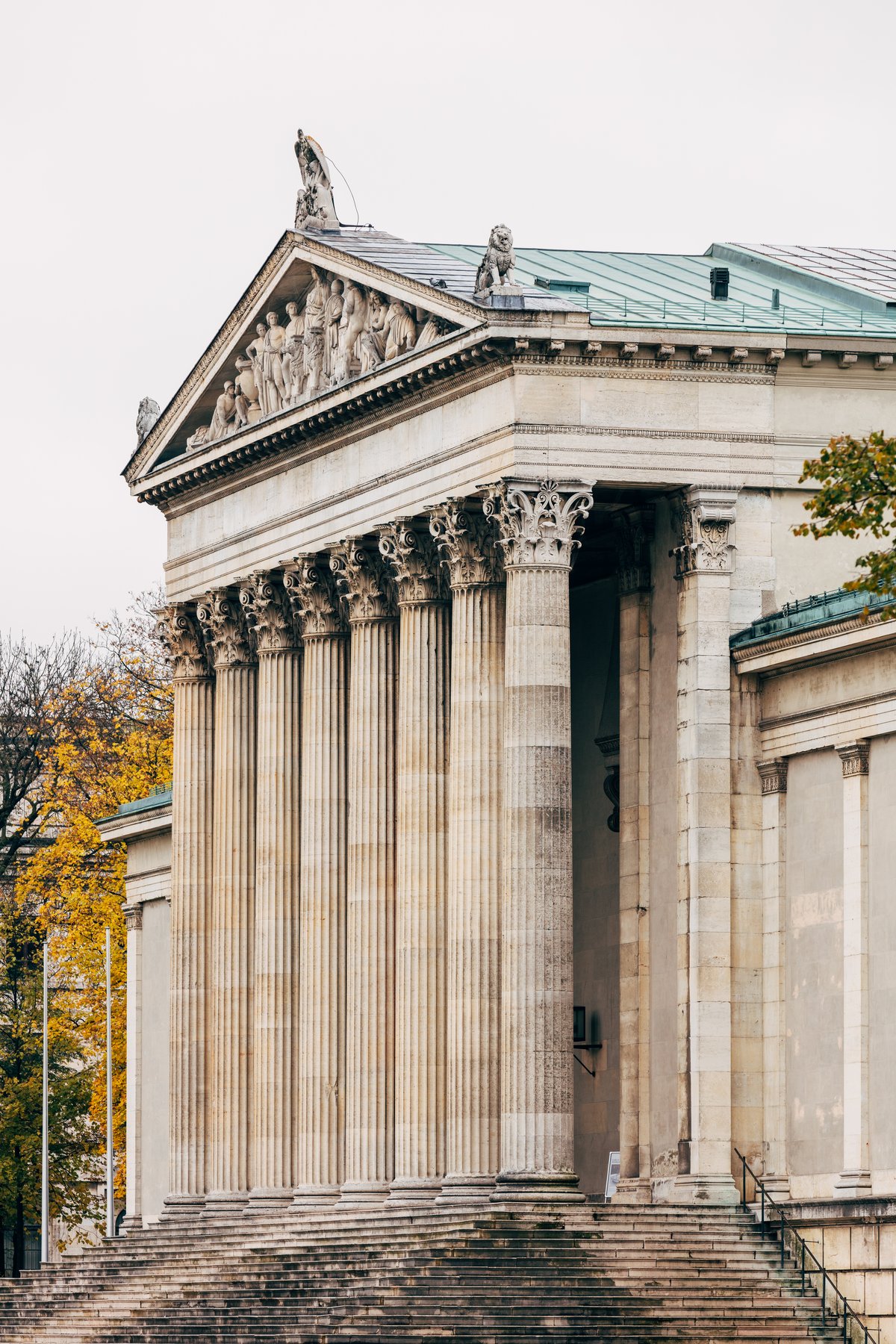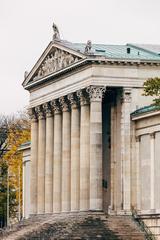
Staatliche Antikensammlungen Munich: Visiting Hours, Tickets, and Comprehensive Guide
Date: 14/06/2025
Introduction
Situated at the heart of Munich’s renowned Kunstareal, the Staatliche Antikensammlungen is a premier museum dedicated to the art and culture of ancient Mediterranean civilizations. With an extraordinary collection of over 8,000 artifacts from Greek, Etruscan, and Roman cultures, the museum offers a captivating journey through antiquity. Housed in a striking neoclassical building designed by Georg Friedrich Ziebland and completed in 1848, the museum is not only a treasure trove of historical objects but also a key part of Munich’s architectural and cultural landscape. This guide provides detailed information on visiting hours, ticketing, accessibility, highlights of the collection, and practical travel tips to help you make the most of your visit to one of Munich’s most important historical sites. (Antikensammlungen official site, britannica.com, en.wikipedia.org)
Table of Contents
- About the Staatliche Antikensammlungen: Overview & Significance
- Historical Background and Architectural Heritage
- Visiting Information (Hours, Tickets, Accessibility, Directions)
- Highlights of the Collections
- Exhibition Approach and Educational Programs
- Research, Conservation, and Institutional Impact
- Visitor Experience: Amenities, Tours, and Nearby Attractions
- Frequently Asked Questions (FAQ)
- Practical Travel Tips
- Summary and Call to Action
- References and Useful Links
About the Staatliche Antikensammlungen: Overview & Significance
The Staatliche Antikensammlungen (State Collections of Antiquities) is one of Germany’s leading museums for classical antiquity. Its comprehensive collections and expert curation have established it as a central institution for the study and appreciation of Greek, Etruscan, and Roman art. The museum is a key component of Munich’s Kunstareal, located directly on Königsplatz, and complements neighboring cultural sites like the Glyptothek. Its roots trace back to the Wittelsbach dynasty, particularly King Ludwig I, whose discerning acquisitions focused on the quality and rarity of ancient artifacts (antike-am-koenigsplatz.mwn.de, britannica.com).
Historical Background and Architectural Heritage
Origins and Development
The museum’s collection is grounded in the European tradition of collecting ancient art, a practice that flourished among monarchs and aristocrats as a sign of erudition and power. In Bavaria, King Ludwig I (1786–1868) significantly expanded the collection, emphasizing the highest artistic standards (en.wikipedia.org).
Architecture
The neoclassical building, completed in 1848, was designed by Georg Friedrich Ziebland. Its grand Corinthian portico and allegorical pediment, featuring the figure of Bavaria and symbolic lions, create a harmonious ensemble with the Glyptothek across Königsplatz. The phoenix atop the roof symbolizes the building’s post-war restoration (life-globe.com). The museum suffered extensive damage in World War II, but careful restoration in the 1960s preserved its historic exterior while modernizing its interiors for contemporary exhibitions (munich.travel).
Visiting Information
Hours and Tickets
- Opening Hours: Tuesday–Sunday, 10:00 AM – 5:00 PM. Closed on Mondays and select public holidays.
- Ticket Prices: Standard adult €7; reduced €5; free for children under 18. On Sundays, many Munich museums offer €1 entry (TimeOut: Munich Travel Tips).
- Guided Tours & Audio Guides: Guided tours are available on weekends and by appointment. Audio guides can be rented for a small fee.
- Special Closures: The museum may close for special events (e.g., concerts on Königsplatz); always confirm on the official website.
Accessibility
The museum is fully accessible, with step-free entrances, ramps, elevators, and staff assistance available. Folding chairs and tactile materials for visually impaired visitors are provided (Antikensammlungen: Accessibility).
Directions and Transportation
- Address: Königsplatz 1, 80333 Munich, Germany
- Public Transport: U2 or U8 U-Bahn to Königsplatz station; Tram 27 (Karolinenplatz); Bus 100 (Königsplatz)
- Parking: Limited paid parking nearby; public transport is recommended due to central location (MVV Munich Transport).
Highlights of the Collections
Greek Antiquities
- Vase Painting: Features masterpieces like the Dionysos-cup by Exekias (c. 540/30 BC), famed for its depiction of Dionysos and dolphins.
- Terracotta Figurines: Tanagra statuettes capturing daily life and mythology.
- Jewelry and Metalwork: Gold jewelry, bronze mirrors, and weaponry of exceptional craftsmanship.
Etruscan Artifacts
- Funerary Objects: Sarcophagi and grave goods illustrating beliefs about the afterlife.
- Bronze Statuettes and Mirrors: Votive and everyday objects reflecting Etruscan artistry.
Roman Antiquities
- Glassware and Mosaics: Delicate Roman glass and mosaic work.
- Portraiture and Sculpture: Busts and reliefs, complementing the Glyptothek’s sculpture collection.
- Coins and Gems: A significant numismatic collection with engraved gems and coins.
Special Highlights
- Apollo of Tenea: Archaic Greek funerary monument (c. 570/60 BC).
- Boy with a Goose: Roman copy of a Greek bronze, exemplifying playful themes in ancient art (Antikensammlungen: Special Exhibitions).
Exhibition Approach and Educational Programs
The museum’s galleries are organized both thematically and chronologically, allowing visitors to follow the evolution of ancient art and social customs. Exhibits are enhanced by bilingual signage, multimedia resources, and regular special exhibitions. Educational programs cater to families, schools, and scholars, offering interactive tours, workshops, and lectures (Antikensammlungen: Visitor Information).
Research, Conservation, and Institutional Impact
The Staatliche Antikensammlungen collaborates with academic institutions such as Ludwig-Maximilians-Universität and international research partners. Its conservation laboratories ensure the ongoing preservation of artifacts. The museum also publishes scholarly catalogues and participates in global research on classical antiquity.
Visitor Experience: Amenities, Tours, and Nearby Attractions
- Facilities: The museum is equipped with restrooms (including accessible facilities), cloakrooms, and lockers. A café is available at the neighboring Glyptothek.
- Audio Guides: Multilingual audio guides are offered for a small fee.
- Museum Shop: Offers scholarly books, replicas, and souvenirs.
- Photography: Permitted without flash; some special exhibitions may have restrictions.
Nearby Attractions
- Glyptothek: Ancient sculpture museum directly opposite.
- Alte Pinakothek, Pinakothek der Moderne, Museum Brandhorst: Major art museums within walking distance.
- Königsplatz: Iconic neoclassical square, ideal for photos and relaxation.
Frequently Asked Questions (FAQ)
Q: Can I buy tickets online?
A: Yes, tickets are available online and at the entrance. Online booking is recommended during busy periods.
Q: Are guided tours available in English?
A: Yes, guided tours in English and other languages can be booked in advance.
Q: Is the museum accessible for wheelchair users?
A: Yes, the museum is fully accessible, with ramps, elevators, and assistance.
Q: Is photography allowed?
A: Personal photography without flash is permitted; check on-site signage for exhibition-specific rules.
Q: What are the best nearby attractions?
A: The Glyptothek, Lenbachhaus, and other Kunstareal museums are all within close proximity.
Practical Travel Tips
- Arrive early for a quieter experience.
- Wear comfortable shoes as the museum involves walking.
- Check the weather before visiting, especially if exploring outdoor areas of Königsplatz (Munich weather data).
- Download the Audiala app for audio guides and interactive maps.
- Use public transport for convenience and to avoid parking hassles.
Summary and Call to Action
The Staatliche Antikensammlungen is an indispensable destination for anyone interested in ancient art, history, and culture. Its extensive collections, accessible facilities, and prime location in Munich’s Kunstareal make it a highlight of the city’s museum scene. Whether you are a scholar, family, or casual visitor, you will find enriching exhibitions, engaging programs, and a welcoming atmosphere. Plan your visit by checking the latest opening hours and events on the official Staatliche Antikensammlungen website. For more tips and updates, follow the museum on social media and use the Audiala app to enhance your cultural journey.
References and Useful Links
- Exploring the Staatliche Antikensammlungen in Munich: History, Architecture & Visitor Guide, 2025
- Staatliche Antikensammlungen Munich: Visiting Hours, Tickets & Historical Significance Guide, 2025
- Visitor Experience and Practical Information at Staatliche Antikensammlungen Munich: Visiting Hours, Tickets & Tips, 2025
- Staatliche Antikensammlungen, Britannica, 2025
- Staatliche Antikensammlungen, Wikipedia, 2025
- Whichmuseum: Art Museums in Munich, 2025
- Munich Travel Tips, TimeOut, 2025
- Staatliche Antikensammlungen, Munich Travel, 2025
- MVV Munich Transport
- Munich weather data
- Königsplatz museums





































































































